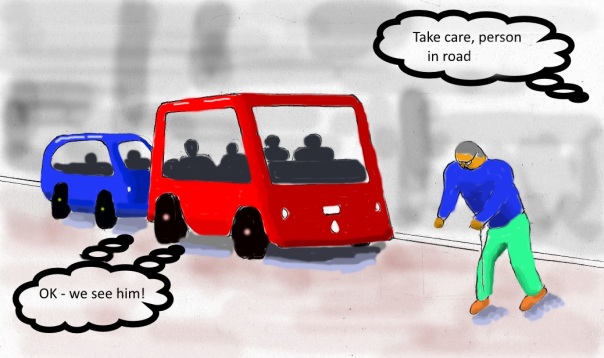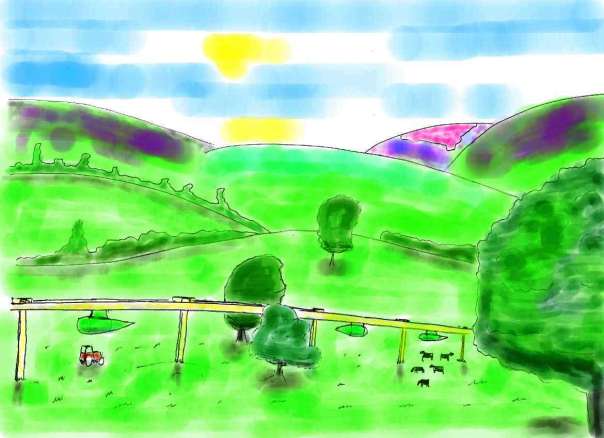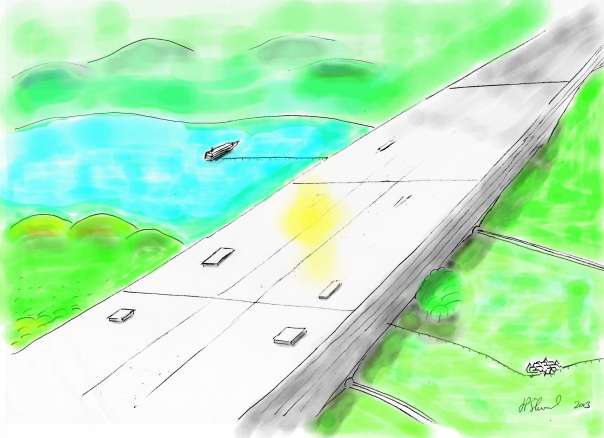This post addresses a important question – how can we make our cities sustainable? It is a really tough question for most cities, because the private car is central to life and each car uses large amounts of energy.
The subject is Derby in the UK, my home city. It shows how technology could allow the city to become sustainable and provide dramatic lifestyle improvements.
 The picture on the left is Derby in 2014. The sketch on the right is the same junction in 2030. What is the difference?
The picture on the left is Derby in 2014. The sketch on the right is the same junction in 2030. What is the difference?
The photo shows the extent to which private cars are dominating the city. The road junction is wide and hard to cross. The pavements are noisy. The area beyond is a car park. This street is actually called Traffic Street.
In the sketch on the right, transport energy use is well under 25% of the 2014 picture. The vehicles are mainly electric buses, each replacing many cars. The smaller vehicles are mainly driverless electric taxis, most of which are also carrying more than one person. Whenever a person needs transport they tell their smart phone. A central computer then offers options for the journey, sharing transport wherever possible to cut costs and energy use.
Shared transport is the key to energy reduction. A car with 4 people uses little more energy than a car with one person, so that energy use per person is cut dramatically. Buses enable even greater savings.
In 2030 the private car has become a luxury item rather than an essential part of life. All journeys can be made using buses and taxis. Some transport is still manned, but driverless technology offers significant cost reductions and is often preferred. Technology is used to ensure that shared transport offers personal security.
The number of people travelling is greater than in 2014, but there are fewer vehicles and the roads have been shrunk. There is now space for cafes and cycle-ways. Parks have been introduced to replace hard surfaces and make drainage more sustainable. The car park has been replaced by shops, offices and homes. The vehicles are travelling at a lower speed, quietly and without fumes. Journey times are faster because there is no congestion. The vehicles are communicating and adjusting their speeds to reduce the need to stop and wait at junctions.The city has been reclaimed for its people, and is far more prosperous. Traffic Street has become People Street.
The sketch below shows an old district, full of terraced housing. Some of the streets have been given glass roofs to allow easy walking, cycling and shopping. This is possible because there are no fumes with electric buses and cars. Water is collected from these roofs and used for watering the city parks
The roof also reduces the heating requirement in the shops and nearby homes. The row of cars are driverless taxis, sitting on induction loops and recharging between trips. They can be called from any mobile phone. Few people own a private car because the narrow streets have no personal parking spaces so recharging is inconvenient. The driverless taxis simply go to the nearest charging area as required.
In summary, Derby is sustainable because it has reduced its energy requirements to be within the capacity of sustainable energy sources.
I have entered this post in the Masdar 2015 Engage blogging contest. That is one reason why it looks at 2030 rather than 2050 as usual. 2030 also makes sense because rapid reductions in carbon emissions are required to avert dangerous climate change.












